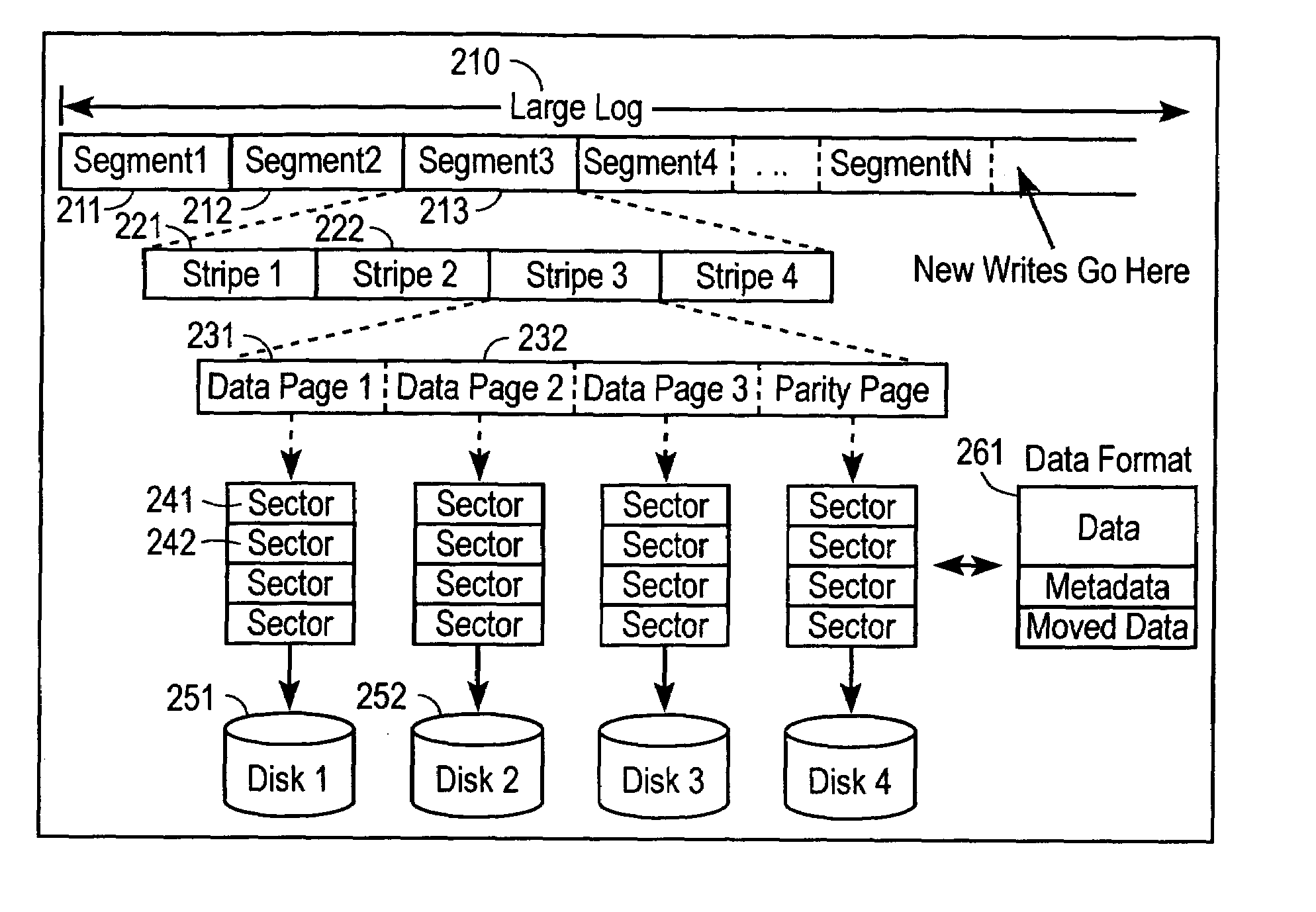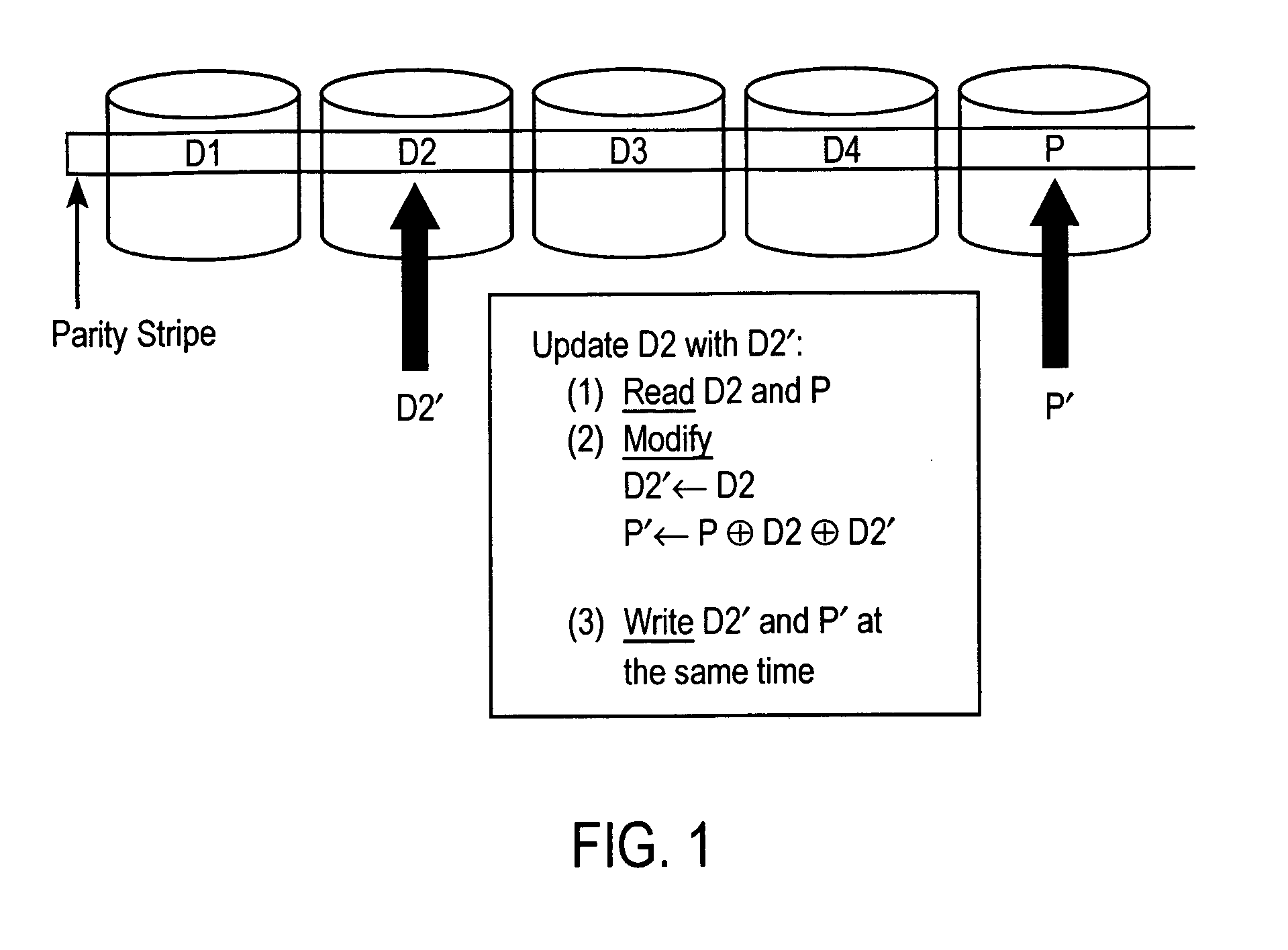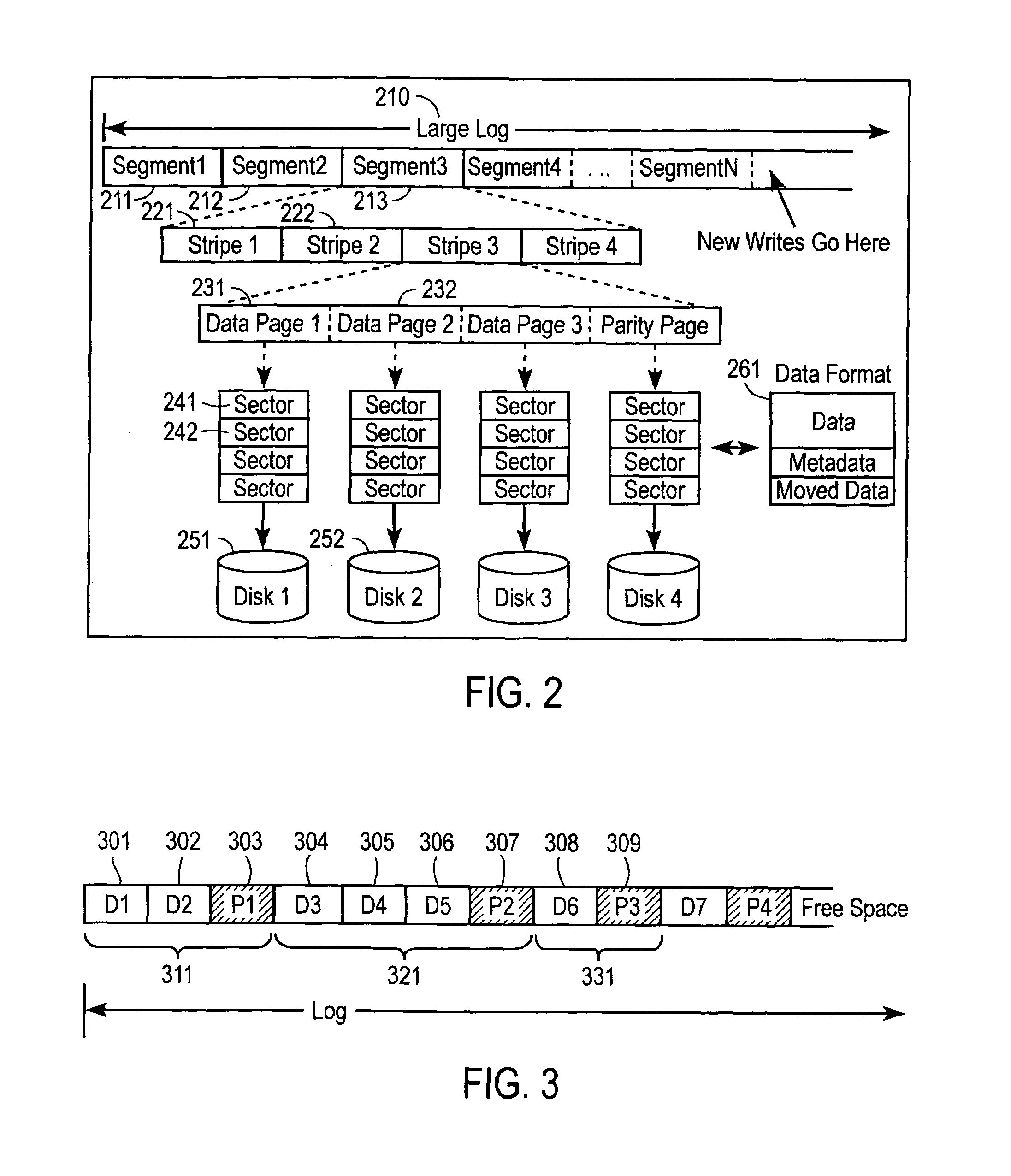Today, even for expensive solutions on
SCSI and
Fibre Channel platforms, there are obstacles to the universal ascendance of RAID Level 5 and the foremost among these is speed.
For instance, one reason that RAID5 is rarely used for OLTP application storage is because of its low performance for such workloads.
As a tradeoff to its
storage efficiency benefits, RAID5 imposes additional computational as well as I / O burdens on the underlying magnetic disk storage.
These additional burdens in many cases result in the general characterization that RAID5 is slower than other types of RAID.
The second performance cost, by far the most extensive, is due to the way that RAID5 typically conducts its writes.
However at the end of any sequential write process and during any modification of data in place, it is not possible to write a complete stripe and the technique of Read-Modify-Write must be employed.
Because of the multiple I / Os required in existing RAID5 implementations, write performance is characteristically poor, often 5×–10×slower than mirroring or striping alternatives.
There are hardware limits to the performance that is achievable given the amount of I / O activity that is generated upon each write.
In addition to low write performance, conventional RAID5 implementations have other performance limitations that are unique to its RAID
flavor.
This initialization process is
time consuming, the magnitude of which is directly related to the size of the RAID set and the capacity of each drive in the group.
Often, during the process of reading all data from the disk to recompute the
missing data and parity, bad sectors may be encountered, and it is no longer possible to rebuild the array.
Depending on the size of the RAID group and the capacity of each drive, the rebuilding process is
time consuming and may degrade the use of the drives in the RAID5 set for normal activity.
Both the initialization and the rebuild processes are additional performance and reliability penalties of conventional RAID5 implementations that will occur as a matter of normal operation.
Based on the dominant approach to implementing RAID5 at present, there are several discrete reliability problems that arise in common implementations.
Many of these reliability concerns are generated by events like power failure, which can often set in motion a
cascade of correlated failures.
For instance, a power failure not only interrupts active writes, which can invalidate any parity that is in the process of being updated, but can also
burn out disks with aging components.
As a result, power failures can often cause
data loss in many types of RAID implementations by destroying both the parity and data associated with a “parity stripe.” Part of this is due to characteristics of the ATA platform itself, such as differences in
assembly line
quality control processes that have more tolerance for production variability.
However a large part of the quality differential is due to ineffective strategies employed by the ATA RAID
community using legacy RAID methodologies.
The most salient reliability problem in the ATA RAID arena is the nearly universal use of write back caching in all ATA implementations, even those driven by hardware RAID solutions.
Quicker completion of writes leads to faster application performance when disk latency is the primary performance limitation.
Though
performance enhancement is helpful, the use of write back caching in ATA RAID implementations presents at least two severe reliability drawbacks.
When power is suddenly lost in the drive bays, the data located in the cache memories of the drives is also lost.
In fact, in addition to
data loss, the drive may also have reordered any pending writes in its write back cache.
Because this data has been already committed as a write from the standpoint of the application, this may make it impossible for the application to perform consistent
crash recovery.
When this type of corruption occurs, it not only causes
data loss to specific applications at specific places on the drive but can frequently corrupt filesystems and effectively cause the loss of all data on the “damaged” disk.
The reason that this more global type of corruption occurs is due to another problem with using a write back cache.
This second problem involves the sequencing of data that enters and exits the write back cache.
This causes corruption as applications are unable to recover from drive failures because they have no way of resolving the order in which data made it to the disk media versus which data was lost in cache.
Even if individual drives did not reorder writes, there is no convenient way of preventing the reordering of writes that are striped across multiple drives that use write back caching, since any individual drive is unaware of the writes being serviced by another drive.
In fact the
weakness of the write back cache is even a relatively well understood problem, and in higher end drive platforms RAID devices and sophisticated storage administrators will default to a policy of prohibiting the use of the
SCSI write back cache.
However, in the ATA RAID arena, the write back cache is usually enabled by default, and performance measurement is conducted with the caching enabled, which is misleading given that the reliability implicit in RAID is compromised by the use of write-back-caching.
The tradeoff for RAID5, however, involves even lower performance.
As discussed in the previous section, the legacy methodologies for RAID5 impose a significant performance limitation on this type of RAID, one that is partially addressed by vendors through the default use of write-back caching.
Unfortunately, deactivating write back caching usually has a dire effect on performance.
And yet, there is a further dilemma.
Since ATA vendors are not currently certifying the
recovery of drives that deactivate write-back caching, it is possible that drives operating without this function will have greater failure rates.
So, while vendors do achieve the goal of preventing an obvious source of
data corruption, they run the risk of increasing drive failure.
The other showstopper problem posed by disk failure in ATA RAID5 solutions is the parity recalculation problem.
If the
system crashes during the middle of a write process, the parity calculation that applied to the
active data write may be inconsistent.
Currently, the parity recalculation problem is a significant drawback of
software RAID5 solutions.
There is no easy way to avoid this penalty when using the traditional read-modify-write approach to RAID5.
This technique is called “dirty region
logging.” If the pointer is stored on another disk, it generates an additional I / O step that will further degrade performance.
Nonetheless, it will deliver a performance benefit by avoiding the need to recalculate all parity upon power failure; however, it does not eliminate the associated reliability problem since, in the event of a
crash, some parity will still be left in an inconsistent state until
recovery can be performed.
If dirty region
logging is combined with write-back-caching, the original reliability problem caused by a power failure or power spike event will result in inconsistent or corrupt data.
This approach, while much more reliable than dirty region
logging, imposes additional disk latency and makes RAID5 writes significantly slower.
Unfortunately, the use of NVRAM will tend to degrade RAID5 performance for streaming where
throughput rather than latency is important.
Nevertheless, it is undesirable for the ATA world to move to this type of solution.
Given this, vendors do not have the luxury to equip ATA RAID solutions with a lot of expensive hardware components.
Moreover, there is some expectation within the ATA
community that the widespread adoption of
serial ATA will result in an increase of drive counts within standard rackmount servers.
In many of these scenarios, the real estate required for additional board-level components will not be readily available on motherboards or easily addressable through the use of expansion boards.
This means that the ATA world will continue to have relatively few options available for addressing reliability concerns associated with RAID5 implementations simply by applying more hardware.
There are several factors that make implementing a flexible and reliable RAID 5
system difficult:Atomic parity update.Small writes require read-modify-write disk operations.Inflexible fixed
data mapping.
If the system crashes or loses power at this time, the parity may be left in an inconsistent state and is useless.
However, if there is already a failed disk or if a disk fails after a system
crash, then the inconsistent parity cannot be used to recover the lost data.
Unfortunately, it is common for power failures to simultaneously crash systems and destroy disks.
Note that most low-end RAID 5 systems probably do not support atomic parity updates and therefore cannot be used in any serious storage application.
Software RAID systems in particular usually cannot assume the existence of a nonvolatile memory device and must log the data and parity to a disk.
This greatly increases the latency for write operations, particularly since many logging systems require more than one synchronous disk operation (write log entry+update size of log) in order to
append to a log.
Another problem with RAID 5 systems is that small writes require reading the old data and old parity and xoring it with the new data in order to generate the new parity.
However, this does not work for small random writes, and most software RAID 5 implementations do not have the luxury of nonvolatile memory.
Finally, most RAID 5 systems use inflexible, fixed data mappings that make it difficult to accommodate the addition, removal or failure of a disk.
 Login to View More
Login to View More  Login to View More
Login to View More 


